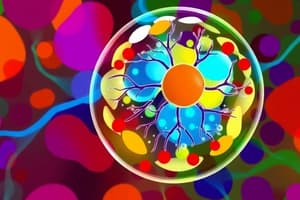Podcast
Questions and Answers
कोशिका जीविका के किस पहलू के लिए महत्वपूर्ण है?
कोशिका जीविका के किस पहलू के लिए महत्वपूर्ण है?
- पोषक तत्वों और कचरे के उत्पादों का विनिमय करने के लिए
- जीविका की मृत्यु और विभाजन के लिए
- प्राण्य जीवन की मूल तत्वों की समझ के लिए (correct)
- संरचनात्मक और कार्यात्मक कोशिकाओं की अध्ययन के लिए
कोशिका की सीमा क्या है?
कोशिका की सीमा क्या है?
- प्राण्य में पोषक पदार्थों का संरचना में मदद करने वाली सीमा
- संरचनात्मक और कार्यात्मक प्रक्रियाओं का समुह
- पोषक तत्वों और कचरे के उत्पादों का विनिमय करने वाली सीमा
- जीविका को संरचना से अलग करने वाली सीमा (correct)
कोशिका में कौन-कौन से महत्वपूर्ण घटक हैं?
कोशिका में कौन-कौन से महत्वपूर्ण घटक हैं?
- कोशिका का संरचनात्मक और कार्यात्मक समझ (correct)
- प्राणी में पोषक पदार्थों की संरचना
- प्राण्य जीवन की मूल तत्वों की समझ
- पोषक पदार्थों और कचरे के उत्पादों का विनिमय
कोशिका में संरचनात्मक और कार्यात्मक प्रक्रियाओं के समुह क्या है?
कोशिका में संरचनात्मक और कार्यात्मक प्रक्रियाओं के समुह क्या है?
जीन नियंत्रण में कौन-कौन से प्रक्रियाएँ शामिल होती हैं?
जीन नियंत्रण में कौन-कौन से प्रक्रियाएँ शामिल होती हैं?
RNA प्रसंस्करण क्या काम करता है?
RNA प्रसंस्करण क्या काम करता है?
कोशिका संवहनन का प्रमुख माध्यम कौन-कौन से होते हैं?
कोशिका संवहनन का प्रमुख माध्यम कौन-कौन से होते हैं?
कोशिका संपर्क का आपसी अंतरंग माध्यम कौन-कौन से होते हैं?
कोशिका संपर्क का आपसी अंतरंग माध्यम कौन-कौन से होते हैं?
सेलर मेटाबोलिज़म में सबसे महत्वपूर्ण प्रक्रिया क्या है?
सेलर मेटाबोलिज़म में सबसे महत्वपूर्ण प्रक्रिया क्या है?
सीटोसॉल का क्या काम है?
सीटोसॉल का क्या काम है?
कौन-सा संरचना संग्रह में संगृहीत और आनुषंसिक सूचना को संतानी रूप से प्रेरित करता है?
कौन-सा संरचना संग्रह में संगृहीत और आनुषंसिक सूचना को संतानी रूप से प्रेरित करता है?
कौन-सी प्रक्रिया के द्वारा पौधों और कुछ जीवों में सूर्यप्रकाश को रासायनिक ऊर्जा में परिणत किया जाता है?
कौन-सी प्रक्रिया के द्वारा पौधों और कुछ जीवों में सूर्यप्रकाश को रासायनिक ऊर्जा में परिणत किया जाता है?
कौन-सी प्रक्रिया सेल्स के परिवेश से संकेत प्राप्त करती है और संकेतों को पुनरुत्पादित करती है?
कौन-सी प्रक्रिया सेल्स के परिवेश से संकेत प्राप्त करती है और संकेतों को पुनरुत्पादित करती है?
Flashcards are hidden until you start studying
Study Notes
Introduction to Cell Biology
Cell biology is an academic discipline that studies cells, focusing on their physiological properties, structure, organelles, interactions with their environment, life cycle, division, and death. This field is crucial for understanding the fundamentals of life, as cells are the structural and functional unit of all known living organisms. The following sections will delve into various subtopics of cell biology, including cell structure and function, cellular metabolism, signal transduction, DNA replication and repair, chromatin biology, gene regulation, RNA processing, and cellular communication.
Cell Structure and Function
Cells are the basic structural and functional units of life, and their study involves understanding their organization and function. Key components of a cell include:
- Cell Membrane: The boundary of the cell, which separates it from its environment and allows for the exchange of nutrients and waste products.
- Cytosol: A gelatinous, semi-transparent fluid that fills most cells, where a portion of cell metabolism occurs.
- Chromosomes: Organized structures of DNA and proteins found in cells, which store and transmit genetic information.
- Plasmids: Extrachromosomal DNA molecules separate from the chromosomal DNA, capable of sexual inheritance.
Cellular Metabolism
Cellular metabolism involves the processes that occur within cells to maintain their structure and function. Key aspects of cellular metabolism include:
- Cell Respiration: The process by which cells convert oxygen and nutrients into carbon dioxide and water, releasing energy in the process.
- Photosynthesis: The process by which plants and some bacteria convert sunlight into chemical energy, chlorophyll being the key pigment involved.
Signal Transduction
Signal transduction is the process by which cells receive and transmit signals from their environment, allowing them to respond to external stimuli. This process involves various cellular components, such as receptors, signal transduction pathways, and effectors.
DNA Replication and Repair
DNA replication is the process by which genetic information is copied prior to cell division, ensuring that each daughter cell receives a complete set of genetic instructions. DNA repair is the process by which cells correct damage to their DNA, ensuring the accurate transmission of genetic information to future generations.
Chromatin Biology and Gene Regulation
Chromatin biology focuses on the organization and function of chromatin, which is a complex of DNA and histone proteins. Gene regulation involves the control of gene expression, which can be achieved through various mechanisms, such as DNA methylation, histone modification, and microRNAs.
RNA Processing
RNA processing involves the modification, splicing, and export of RNA molecules from the nucleus to the cytoplasm. This process is essential for the expression of genes and the synthesis of proteins.
Cellular Communication
Cellular communication is the exchange of information between cells, which can occur through various mechanisms, such as the release of hormones, neurotransmitters, or cytokines, and the binding of ligands to cell surface receptors.
Conclusion
Cell biology is a vast field that encompasses various subtopics, from cell structure and function to cellular communication and gene regulation. By studying cells, researchers can gain a deeper understanding of the mechanisms that underlie life and disease, ultimately leading to advancements in medicine, agriculture, and technology. As the field of cell biology continues to evolve, the interdisciplinary approach of systems biology is increasingly being employed to study living systems within the context of other biological disciplines.
Studying That Suits You
Use AI to generate personalized quizzes and flashcards to suit your learning preferences.




